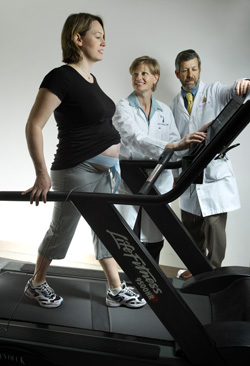
Innovations in Gynecology
January 1, 2013

But he and his colleague Linda Szymanski, a maternal-fetal medicine physician with a Ph.D. in exercise physiology, are doing their part to change that. Recently they published two articles on their research to evaluate fetal responses to strenuous exercise in 45 physically active and inactive women during their third trimester. The results showed that even inactive healthy women can exercise moderately, and athletes may continue vigorous exercise safely. All the mothers delivered without complications.
Now she and Satin are enrolling pregnant women, including those with chronic hypertension, in a clinical trial. The studies require the women to undergo peak and moderate exercise tests on a treadmill, while Szymanski measures how different intensity levels affect the fetus. Ultrasound exams immediately follow the women’s exercise. “The difference between our studies and existing studies, “says Szymanski, “is that we are differentiating between fit women and women who do not exercise. We’re also looking at fetal response to exercise in a practical way—that is, walking on a treadmill at the intensity and duration currently recommended by public health experts.”
It’s generally agreed that absent known contraindications, exercise reduces common discomforts and helps prevent gestational diabetes and possibly preeclampsia. The Department of Health and Human Services, for example, recommends two and a half hours of moderate aerobic exercise per week. Common sense should also prevail: Pregnancy isn’t the time to take up activities like kickboxing or skiing, where the abdomen can get hit. Still, says Szymanski, guidelines are vague, and few studies have evaluated the fetal response to exercise.
Although the pair’s initial results boost the case for workouts, Satin says, “we still advise women to talk first with their physicians to make sure obstetric conditions won’t compromise their health or that of the fetus.”

